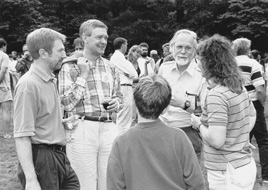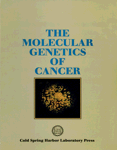|
LIX: The Molecular Genetics of Cancer 1994 |
|
|

|
From left: Dr. Gordon Peters, Dr. Jan Witkowski, Dr. J. Michael Bishop, Dr. Carol Greider SYMPOSIUM SYNOPSIS LIST OF PARTICIPANTS CONTENTS OF SYMPOSIUM VOLUME PHOTOGRAPHS PUBLISHED VOLUME  |
The Molecular Genetics of Cancer
June 1- 8, 1994
Symposium Synopsis
Organizer: Bruce Stillman
Advisors: Eric Fearon, Ed Harlow, Michael Gottesman, Thea Tlsty, David Stewart and Bert Vogelstein.
This was the third in three Symposia dealing with cancer, stretching over a 20 year period; the first was on Tumor Viruses (1974) and the second on Viral Oncogenes (1979). But while this is the third Symposium on cancer, it is, in fact, the fourth in a series of meetings on cancer at Cold Spring Harbor; a special meeting on The Origins of Human Cancer was held in the Laboratory’s centennial year, 1990. (Organized by Joan Brugge, Tom Curran, Ed Harlow, and Frank McCormick, the meeting volume was published in 1991 as Origins of Human Cancer: A Comprehensive Review by Cold Spring Harbor Laboratory Press.)
The differences between the 1979 and 1994 Symposia are remarkable. In 1979, the viral oncogene src had been discovered and it had been realized that it was derived from a cellular gene. But as the application of recombinant DNA techniques to caner research will still in their infancy, the viruses remained the objects of study. Apart from Howard Temin in his introduction, human cancer was notable by its absence from the 1979 program. By contrast, the names of viral proteins appear in only two out of 86 presentations, and the majority of papers dealt with the molecular characterization of human cancer genes and the biochemical analysis of the functions of their proteins. By 1994, among others, genes involved in breast cancer (BRCA1), colon cancer (APC; DCC); myeloid leukemia (AML1); and myelogenous leukemia (c-ABL) had been cloned.
What is evident from the contents of the Symposium is the extent to which Howard Temin’s hope of 15 years earlier– “...tumor viruses may provide simple agents to study the processes and the molecules involved in all oncogenesis and in much differentiation”–had been realized. The first three sections dealt with cellular functions and processes that when things go awry lead to oncogenesis. The first section was on the cell cycle and its regulation, including cell senescence. There was even one paper (but only one) on development–Gerry Rubin’s paper on ras signaling in Drosophila eye development. The second section covered DNA damage and repair, while the third discussed apoptosis.
But, as Ed Harlow pointed out in his summary of the meeting, there remained a huge gap between the clinical care of patients and the world of basic cancer research. There were some bright spots–there had been a session on therapies–but the application of research findings to clinical practice was still the major challenge. Harlow noted that he had come to the Symposium not knowing whether he would become depressed by all that remained to be discovered about cancer. He was pleased to find that he was enthusiastic: “We continue to make impressive strides, and with each one a little more of the puzzle is solved.”
Search images: